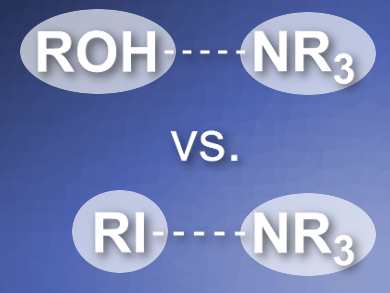In the well-known hydrogen bonds, a positively charged hydrogen atom interacts with an electron donor (pictured top). They are among the strongest and most important intermolecular interactions. In halogen bonds, on the other hand, a halogen atom, usually iodine, acts in similar fashion (pictured bottom). In a three-component system, there can be a competition between the formation of hydrogen bonds and halogen bonds.
Robin N. Perutz, University of York, Christopher A. Hunter, University of Cambridge, Lee Brammer, University of Sheffield, all UK, and colleagues have studied the effects of solvents on this competition. The team observed the effect of seven different solvents, from polar i-propanol to nonpolar toluene, on the assembly of co-crystals from mixtures of 1,4-diiodotetrafluorobenzene, hydroquinone derivatives, and 1,2-bis(4-pyridyl)ethane. These molecules each feature two acceptor or donor groups and can form linear networks, stabilized by hydrogen or halogen bonds. The iodo- and hydroxy-groups compete for interaction with the pyridine nitrogen atoms.
The researchers found that in nonpolar solvents, the formation of hydrogen-bonded co-crystals is preferred, while in polar solvents, halogen-bonded co-crystals are formed. This can be attributed to the fact that polar solvents weaken hydrogen bonds in solution and favor the formation of halogen-bonded co-crystals. When the hydrogen-bond interaction is stronger, e.g., with fluorinated hydroquinone derivatives, the solvent needs to be more polar to cause this effect. According to the researchers, the solvent-control of intermolecular interactions could be important for other areas of self-assembly and molecular recognition, not just co-crystallization.
- Hydrogen bonding vs. halogen bonding: the solvent decides,
Craig. C. Robertson, James S. Wright, Elliot J. Carrington, Robin N. Perutz, Christopher A. Hunter, Lee Brammer,
Chem. Sci. 2017.
DOI: 10.1039/c7sc01801k
